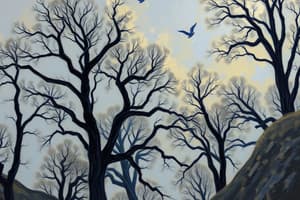Podcast
Questions and Answers
Which event of 1929 marked the beginning of the Great Depression?
Which event of 1929 marked the beginning of the Great Depression?
- The Wall Street Crash (correct)
- The Bolshevik Revolution
- The start of World War II
- The Roaring Twenties
What is the term used to describe writers who were disillusioned by World War I and its aftermath?
What is the term used to describe writers who were disillusioned by World War I and its aftermath?
- The Lost Generation (correct)
- The Southern Renaissance
- The Modernist Movement
- The Conservative Era
Which author wrote the novel 'The Grapes of Wrath' in 1939?
Which author wrote the novel 'The Grapes of Wrath' in 1939?
- Ernest Hemingway
- Francis Scott Fitzgerald
- Gertrude Stein
- John Steinbeck (correct)
What was the name of the county in which William Faulkner's novel 'Absalom, Absalom!' is set?
What was the name of the county in which William Faulkner's novel 'Absalom, Absalom!' is set?
Which poet wrote the poem 'To a Mouse' in 1785?
Which poet wrote the poem 'To a Mouse' in 1785?
What were the main themes of Modernist writers?
What were the main themes of Modernist writers?
What is the name of the wife of Curly in John Steinbeck's novel 'Of Mice and Men'?
What is the name of the wife of Curly in John Steinbeck's novel 'Of Mice and Men'?
Flashcards
The Wall Street Crash
The Wall Street Crash
The event in 1929 that triggered the Great Depression, marked by a steep decline in stock prices.
The Lost Generation
The Lost Generation
A group of writers who were disillusioned by World War I and its aftermath, known for their themes of lost innocence and disillusionment.
The Grapes of Wrath
The Grapes of Wrath
John Steinbeck's novel depicting the hardships of the Dust Bowl era and the migration of Oklahoman farmers to California.
Yoknapatawpha County
Yoknapatawpha County
Signup and view all the flashcards
John Steinbeck
John Steinbeck
Signup and view all the flashcards
Themes of Modernist Writers
Themes of Modernist Writers
Signup and view all the flashcards
Curly's Wife
Curly's Wife
Signup and view all the flashcards
Study Notes
The Interwar Period (1915-1945)
- World War I occurred from 1914-1918, leading to the Bolshevik Revolution in Russia in 1917
- The Roaring Twenties in the USA brought prosperity and new technologies, but were followed by the Wall Street Crash of 1929 and the Great Depression of 1930
- World War II took place from 1939-1945
Modernism
- Modernist writers were disillusioned by World War I, the Great Depression, and World War II
- Common themes in modernist literature include alienation, isolation, individual perception, and human consciousness
- Modernist writers reinvented traditional forms and explored new ways of storytelling
The Lost Generation
- The term "Lost Generation" was coined in the 1920s to describe a group of American expatriates who lived in Paris
- Notable writers from this generation include Ernest Hemingway, F. Scott Fitzgerald, and Gertrude Stein
- F. Scott Fitzgerald's novel "The Great Gatsby" (1925) is a classic of the era
Social Awareness in Literature
- John Steinbeck's novel "The Grapes of Wrath" (1939) addressed the Great Depression and the Oklahoma Dust Bowl
- Steinbeck's novel is set during the Great Depression and explores themes of migration and poverty
- Robert Burns' poem "To a Mouse" (1785) is a classic work that explores similar themes of hardship and struggle
Southern Literature
- William Faulkner was a notable Southern writer who often set his stories in the fictional Yoknapatawpha County
- Faulkner's novel "Absalom, Absalom!" (1936) is a classic of Southern literature
- The title "Absalom, Absalom!" refers to a story from the Bible (2 Samuel 13-18) about King David's son Absalom
Studying That Suits You
Use AI to generate personalized quizzes and flashcards to suit your learning preferences.




